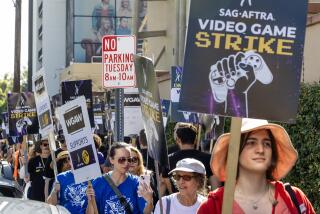Actors unions and studios work overtime on contract talks
- Share via
Negotiators for Hollywood’s actors unions and the major studios worked past their deadline and into the night Saturday in an eleventh-hour effort to reach an early agreement on a new three-year labor contract.
The Screen Actors Guild and the American Federation of Television and Radio Artists began negotiations on Sept. 27, nearly nine months before the current film and TV contract expires. SAG has 125,000 members. Its sister union, AFTRA, has 70,000.
Both sides had agreed to early negotiations to avoid a repeat of what happened two years ago, when SAG and the studios were locked in a standoff that disrupted film and television production and caused actors to work without a contract for about a year.
SAG is now led by a coalition of moderates, who fired former Executive Director Doug Allen last year and replaced him with David White, a former SAG general counsel who has taken a less confrontational approach in his dealings with the studios.
Despite the improved relations, it was unclear whether White and his co-chief negotiator, AFTRA Executive Director Kim Roberts Hedgpeth, would be able wrangle a deal from the studios Saturday night or would need more time to bridge differences over bread-and-butter economic issues.
The actors unions are seeking more than the 2% annual raises recently won by the Teamsters, citing salary “compression” that has squeezed the income of actors. Many actors are no longer able to earn the fees they once commanded and have seen a decline in TV residuals — fees they earn from reruns — because fewer shows are repeating on networks or later sold into syndication.
The unions also want increases in contributions that employers make to their health and pension plans, which have been hit by investment losses and rising medical costs. SAG’s health plan is facing a $30-million deficit this year.
Another sticking point, people familiar with the negotiations said, involved efforts by the unions to secure improved pay and work conditions for actors who perform on a “motion capture” stage, a concern fueled by the huge success of James Cameron’s blockbuster “Avatar.” Motion capture is a process in filmmaking in which the actions and movements of humans are digitally recorded, or captured, to create computer animated characters. Such performers are either not covered under a union contract or do not receive the same union pay as principal performers.
Studios, however, have resisted some of the demands, citing austerity measures they have taken during the recession, such as scaling back development deals, laying off staff and cutting film and TV budgets. Studios also are struggling to find new revenue streams to replace losses from falling DVD sales, long their primary source of profit.
SAG and AFTRA face pressure to conclude an agreement before the Directors Guild of America launches its own negotiations with the studios this month. The directors union is traditionally the first out of the gate on new contracts, setting the pattern for others.
More to Read
The biggest entertainment stories
Get our big stories about Hollywood, film, television, music, arts, culture and more right in your inbox as soon as they publish.
You may occasionally receive promotional content from the Los Angeles Times.











